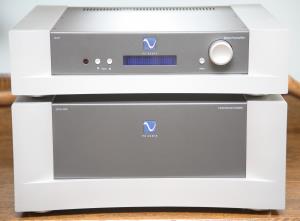|
|||||||||
|
I have been a fan of PS Audio products for a long time, not just because they are high quality, but because I also really like Paul McGowan, president of PS Audio. He is so enthusiastic about what he does, the fun just rubs off on anyone who talks to him. We have reviewed their Power Plants, which regenerate the AC power into a clean sine wave, and more recently, one of their two-channel power amplifiers, the GCA-250. In the current article, I review their GCP 200 Stereo Preamplifier, and their GCA MC-500 Five-Channel Power Amplifier. The GCA MC-500 differs from the GCA-250 in having five channels instead of two, and having a lot more power. Other than that, they are similar in having the Gain Cell technology that PS Audio has introduced. The Gain Cell is a circuit contained within a small box inside the chassis, which applies gain to whatever signal is input. This can be used in a preamplifier or power amplifier. The Gain Cell is employed both in the GCP 200 and GCA MC-500 reviewed here. The Design The Gain Cell can be utilized in a pure analog design such as the GCP 200, but also in digital switching products, such as the GCA-MC-500. In the case of the preamplifier, all stages, including the Gain Cell, are analog. For the power amplifier, although the Gain Cell is analog, the output stage is PWM (Pulse Width Modulation), which means that the output voltage is switched on and off for varying amounts of time (micro-seconds) to produce the waveform (the music). The advantage of doing this is that the amplifier is extremely efficient, so the power supply does not waste much energy at all in heat disippation (the GCP MC-500 barely got warm regardless of how loud I was playing the music). As a result, a given power supply can deliver more wattage at the output. In the case of the GCA MC-500, the rated output is 500 watts RMS into 8 ohms, and 1,000 watts RMS into 4 ohms. Each channel is independent of the other (modular), so you are really only limited by the wall AC socket and your circuit breaker box. The disadvantages include radio frequency noise (the switching frequency, which is 500 kHz for the GCP series) and a tendency to be very sensitive to the speaker's varying impedance depending on the frequency of the signal.
The noise is controlled by shielding the circuits, and PS
Audio has improved the load sensitivity to a point that it is not an issue
in their amplifiers. Basically, this involves making the damping factor so
high - in the thousands - that the speaker load, regardless of how it
varies, does not affect the signal. Both the GCP and GCA are very attractive units, with a satin gray and tan chassis. The front is very simple, with blue LED readouts and a blue panel light at the bottom. The lights can be dimmed if you like, but I am one of those consumers who really enjoys panel lighting. It gives me a visual anchor in a dark room when I am watching movies, and in bright room lighting, the panel illumination is not really visible anyway. The on/off button is the blue square with the white sine wave on it. The rear panels are loaded with features. They both have RCA as well as XLR inputs. The preamplifier has six sets of RCA and one set of XLR. I am a big fan of balanced connections, so I would have liked to have three RCA and three XLR. You can see on the power amplifier that two blank panels are there. These are for the seven-channel version. The speaker binding posts are gold-plated and very heavy. Good idea when you are outputting 500 watts RMS. The posts will lock a banana plug, by first loosening the post, then inserting the plug, and then tightening it down. For the XLR inputs on the power amplifier, you can select one of two input sensitivities, in case your preamplifier has too much or not enough output. For the combo reviewed here, I set it to the most sensitive position, and used the XLR connections, which gave me the best signal to noise ratio. In fact, I could not hear any noise at all (hum or hiss) with the pair in my system. You can click on the photo below to see a larger version. The remote control is small and simple, with controls for Power, Volume, Balance, Phase, Inputs, and Dimming the Panel Lights. The HT button sends the signal through at the same voltage level as it is input, bypassing the volume and balance controls. This is for use with an SSP or receiver. You can name the inputs and adjust the input gain for each input set by accessing the set-up menu by pressing the Up and Down Input buttons and turning the power on, selecting the option using the Mute button, and using the Volume Control to select items in that option menu. Click on the Photo Above to See a Larger Version.
|
|||||||||







